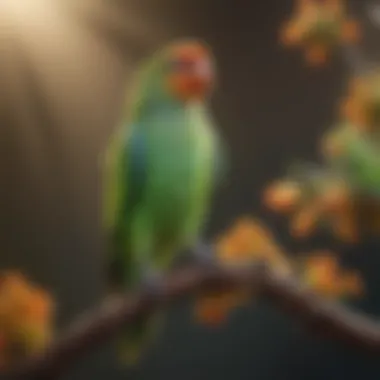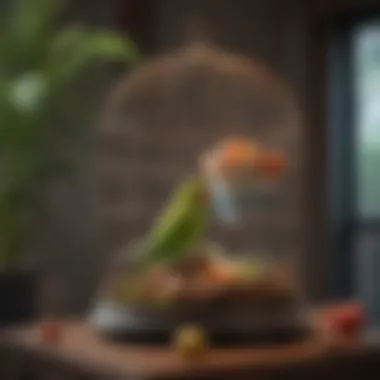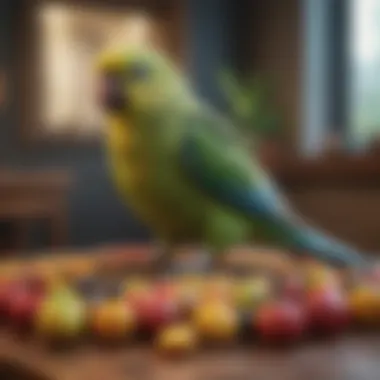Understanding the Financial Aspects of Parakeet Ownership


Intro
Bringing a parakeet into your home can be an exciting decision. However, this enthusiasm often comes with a need for careful planning. For many future owners, it’s crucial to gain a detailed insight into the financial implications before securing such an avian companion. The enjoyable color and lively personality parakeets offer do not negate the considerable expenses tied to their care and well-being. This article will provide pertinent information to assist prospective owners in making informed choices. We will explore the various costs involved in parakeet ownership, dissect the expenses for a clearer picture, and discuss factors that influence these costs.
Care Tips
Taking proper care of parakeets requires diligently following certain routines and practices. Establishing good habits from the start saves both money and fosters a better living environment for your bird.
Daily Care Routines
Daily care routines are fundamental to keeping a parakeet healthy. These include providing fresh water and checking food supplies every day. An hour or two of social interaction, talking, and playtime is also essential for maintaining a parakeet's mental enrichment.
Cage Setup and Maintenance
Setting up an appropriate cage is vital. An adequately sized cage, such as an “A&E Cage Co. Flight Bird Cage,” is necessary for proper movement. Expect to pay considerable amounts upfront for purchasing a quality cage along with necessary accessories. Maintain the cage by cleaning it frequently to avoid disease and ensuring all components are safe, free from wear, and suitable for your parakeet.
Hygiene and Cleaning Practices
Hygiene plays a critical role in your pet's life. Clean food and water dishes daily. Also, a sincere deep-clean, including changing bedding and disinfecting surfaces inside the cage, is essential once a week to maintain a healthy space for your bird.
Seasonal Care Adjustments
Seasonal changes may require adjustments in care. In colder months, ensure consistent heating and protect from cold drafts. Conversely, during warm seasons, avoiding hot areas where the bird may become stressed is crucial. Adjust the amount of sunlight exposure according to the time of year. Your parakeet’s specific species will further dictate seasonal requirements.
Behavioral Insights
Understanding your parakeet's body language provides vital insight into their needs and emotions. Recognizing common warning signs aids owners in addressing potential problems quickly.
Understanding Bird Body Language
Parakeets often exhibit emotions through body language. Signs of relaxation include ear feathers slightly turned and comfortable positions in their cage. Territorial display, such as aggressive postures, should not be ignored. Engaging seriously with your bird gives you a better grasp of their wishes.
Common Behavioral Issues and Solutions
Among typical behavioral concerns, excessive screaming, feather plucking, or biting may arise. Establishing a consistent schedule, providing interactive toys, or consulting a veterinarian can help resolve these issues.
Positive Reinforcement Techniques
Training a parakeet with positive reinforcement builds trust. Rewarding with small treats, like millet spray or favorite fruits, encourages learning and acceptance.
Social Interaction Needs
Both mental health and social needs must be satisfied. Parakeets thrive on sociability. Daily interactions with humans or fellow bird companions should be ensured to prevent anxiety and loneliness.
Nutrition Guides
The correct diet plays a crucial role in your parakeet’s health and life expectancy. Understanding the ins and outs of nutritional needs is indispensable for all potential owners.
Essential Diet Components
A balanced diet consists of quality pellets combined with fresh vegetables, seeds, and fruits. Important nutrients include vitamins A, D, E, and calcium, not forgeting variety increases engagement.
Safe and Toxic Foods
Be aware of foods that can poison your parakeet. A few examples of toxic foods are avocado, chocolate, and caffeine, among other things. Ensuring your bird eats only safe items is a crucial responsibility.
Supplements and Treats
In moderation, calcium supplements and seeds like sunflower seeds can be woven into feeding routines. Treats like carrots or kale fixate attention and keep meals exciting.
Feeding Strategies for Different Species
Some species of parakeets may demand unique dietary attention. Consult vet recommendations regarding species distinctions for an optimized meal plan.
Wellness and Health
Regular vet visits are unparalleled in controlling costs linked to illnesses. Keeping your parakeet healthy saves on unexpected expenses.


Routine Health Checkups
Ensure you have established routine health check-ups once a year with a trusted veterinarian. Be thorough in seeking signs of disease by checking feathers regularly and monitoring diet situations often.
Identifying Symptoms of Illness
Owners should become familiar with common signs, such as lethargy, changes in droppings, or loss of appetite that may indicate health concerns.
Preventative Care and Vaccinations
Adequate preventative care strategies bluntly help avoid illnesses. Make sure that your parakeet maintains vaccinations as necessary, drink clean water, and bask under adequate light.
Mental and Emotional Well-being
Mental well-being is as necessary as physical health. Continuous social interaction paired with mental stimulation via toys or visitor routines keeps your bird engaged and happy.
Enriching Activities
Pet ownership goes beyond simply feeding and cleaning. Engaging your parakeet with stimulating tasks enhances their happiness and quality of life.
Toys and Playtime Ideas
Rotate toys frequently, providing various play objects that stimulate their intellect. Ensure everything is bird safe and actively playful.
Training and Tricks
Invest time engaging with your parakeet to learn simple tricks. Start from recognition of their names to minor pivots or spins for an engaging interaction with your bird.
Outdoor Activities and Interaction
Supervised time outdoors can diversify the experience for your parakeet. Placing a bird harness or close in a cage aids in ajusting their stimuli before letting loose for interactions avoids any stressful moments.
DIY Projects for Mental Stimulation
Creating hiding spots inside the cage for snacks that they have to discover works well for maintaining intrigue and mind sharpening ventures.
Assessing the investment time and money surrounding the acquisition of a parakeet fortifies responsible pet ownership and includes the pet's well-being into the foundation of your family’s life.
Intro to Parakeets
Owning a parakeet is not merely about having a pet; it entails a commitment to understanding the financial and emotional responsibilities that come with it. Parakeets, known for their sociable nature and engaging behaviors, are among the most popular pet birds. However, before welcoming this vibrant creature into your home, it's essential to comprehend the full scope of costs associated with ownership.
Understanding the costs involves more than just the purchase price. Many elements contribute to the overall investment in a parakeet. Each aspect, from initial expenditures like purchase price and necessary equipment to ongoing costs such as food and healthcare, warrants careful consideration. By delving into these financial requirements, potential owners can prepare accordingly, ensuring their setup aligns with their budget and their new bird's needs.
Furthermore, it is significant to highlight that owning a parakeet comes with various long-term implications. Whether you’re an aspiring bird parent or an experienced pet owner considering expanding your family with an avian companion, grasping these elements is vital. This insight will allow comprehensive planning, making the journey smoother for both the owner and the bird.
Owning a parakeet is not just an emotional endeavor; it requires careful financial planning to ensure a stable and fulfilling home for the bird.
Proper preparation also involves understanding specific considerations. Factors affecting parakeet care costs include geographical differences, available resources in your area, and the bird's species.
Ultimately, a knowledgeable decision regarding parakeet ownership leads to a rewarding companionship. The information presented in this article aims to equip you with the understanding needed to navigate the financial landscape of parakeet care, ultimately fostering a happy environment for your future feathered friend.
Initial Costs of Owning a Parakeet
The initial costs of owning a parakeet cover various aspects. This phase is crucial for potential parakeet owners to grasp. Before deciding, it is essential to understand the financial commitment involved. These expenses include the purchase price of the bird and other necessary supplies that one must budget for. By evaluating these costs, future owners can make informed decisions to avoid unpleasant surprises.
Purchase Price of Parakeets
The purchase price represents the first of many costs associated with parakeet ownership. The price can range significantly based on various aspects. Generally, first-time owners may not always consider that the initial outlay could impact their long-term budget. On average, acquiring a parakeet can range from $15 to $200 depending on its sales channel and specific characteristics.
Factors Influencing Purchase Price
Many elements affect the purchase price before making a financial commitment.
Species Variation
Several species of parakeets exist, each affecting the cost. Popular varieties like the Budgerigar tend to be more affordable compared to rare species. This is because the common types are in more consistent supply. The vibrant colors and patterns influence their popularity, thus broadening options for buyers. Nevertheless, different species offer unique traits in temperament and demands. Keep in mind that while common species may be cheaper, unique traits can lead to higher stress or specific needs requiring more resources.
Breeder Reputability


When it comes to breeder reputability, not all sources are equal. Reputable breeders often charge higher prices. This price reflects their commitment to responsible breeding practices and bird wellness. Prospective owners should prefer established breeders with verifiable histories for health and temperament. This practice minimizes potential issues and could save further vet costs down the line. A popular price might seem appealing, but sometimes it hides ethical concerns about the bird’s treatment during their formative weeks.
Age and Rarity
A parakeet’s age contributes significantly to its cost. Young birds often cost more than older ones, primarily due to higher demand for them. Customers frequently seek young pets as they are perceived to adapt better to new environments. Rarer parakeet species also warrant higher price tags. For those considering a specific species or age group, additional research often proves necessary to assess market availability and pricing trends. In sum, each layer of these factors affects overall financial decisions when choosing a parakeet.
Essential Supplies for Parakeets
Owning a parakeet is not purely about the joy of companionship. It also requires a commitment to meet various needs. Essential supplies play a significant role in ensuring that the bird is healthy, content, and capable of thriving in a domestic environment. This segment covers the many aspects linked with parakeet supplies, focusing on housing and dietary needs.
Housing Requirements
Cages, Accessories, and Setup
Cages serve as a foundational piece of equipment for parakeet care. The layout, size, and comfort of the cage significantly influence a parakeet's well-being. An optimal cage is spacious enough. It should allow the bird to move freely, flapping its wings without restriction.
When selecting a cage, look for one with horizontal bars. This allows the bird to climb and exercise more easily. In addition, the cage should include appropriate accessories, like perches, toys, and food bowls. These elements enrich the bird's environment. Many owners choose multi-level setups where parakeets can play and explore.
One feature to discuss is the tray. A removable tray for dropping waste simplifies cleaning. However, it may still require barrier papers or a clean-up routine. Choosing high-quality materials with non-toxic designs ensures that everything within the cage is safe from harm.
Every connected component is crucial in building a safe and stimulating space for a parakeet.
Dietary Needs
Diet plays a vital role in the health of parakeets. Focusing on optimal dietary supplies can result in a noticeable difference in their overall condition. An appropriate balance mainly lies between seeds, pellets, and supplements.
Seed and Pellet Costs
Various seed mixes are available. They provide essential fatty acids and proteins needed for the bird’s nutrition. Seed mixtures help mimic the natural diets of parakeets while offering variety. Pellets, on the other hand, aim to deliver a more balanced nutrition profile. They often provide benefits due to their complete formulation of vitamins and minerals.
The cost associated with seeds and pellets can greatly vary. Depending on the brand and type, some packages might meet different spaces in price ranges. An important point is to remain aware of portion sizes. Overfeeding may lead to obesity, leading to health problems long term.
Fresh Food and Supplements
Fresh food supplementation adds nutritious options that can excite parakeets. This can include fruits and legumes. Common choices involve apples, carrots, and leafy greens, but it's essential to check for safe foods. The positive side is that many birds enjoy fresh fruits, which fosters bonding moments with their human caretakers.
Costs for fresh food fluctuate but remain fairly manageable. Maintaining daily variety satisfies not only their physical needs but their psychological requirement for stimulation. A keen observation on dietary preferences also assists future shopping decisions, ensuring there is always something enjoyable on their menu.
In summary, proper supplies equip parakeet owners to create a nurturing environment. Both housing and dietary needs maximize happiness and health, which ultimately enrich the ownership experience.
Routine Healthcare Expenses
Routine healthcare expenses play a crucial role in the economic evaluation of keeping a parakeet. These costs ensure that parakeets remain healthy and can help identify health issues early. Understanding these expenses allows potential owners to be more prepared financially and enhance the well-being of their future pets.
Initial Veterinary Visits
The first visit to a veterinarian is essential once you bring your parakeet home. This initial check-up generally includes a comprehensive health assessment. During this visit, the vet will examine the bird's feathers, eyes, and beak while assessing its overall condition. Owners also receive guidance on appropriate diets and potential behavioral issues.
Many veterinarians recommend this visit shortly after adoption to set a health baseline, which can be beneficial for future treatments. Expect costs to be relatively moderate when compared to emergency care, usually ranging from $50 to $100. Factor in these costs when calculating the financial commitment of parakeet ownership.
Regular Check-ups and Vaccinations
Maintenance of optimal health for parakeets includes regular check-ups and vaccinations. Veterinarians often suggest annual visits for these small pets. Consistent monitoring can lead to the prevention of diseases and ensure that vaccinations are administered as needed. Common vaccines for birds include those for Psittacine Beak and Feather Disease, though recommendations can vary depending on regional health risks.
The cost for these check-ups implements a manageable burden but accumulates over time. Typically, each visit costs between $40 and $80. Factors such as varying vet clinic prices and location significantly influence these expenses. Setting funds aside for this annual expense helps maintain even budgeting as a parakeet owner.
Emergency Medical Costs
Emergencies happen, even with the best care. Emergency medical costs can be significantly higher than routine visits. It'svital to prepare for unpredicted medical situations like injuries or sudden illness. A common emergency can be associated with a broken leg or other wounding injuries resulting from interactions with toys.
Essentially, emergency vet visits usually range from $100 to $300, depending on the medical attention required and any necessary follow-up treatments. Over time, cumulative costs of routine visits, vaccination needs, and emergency situations can present serious financial commitment. Setting aside an emergency fund specifically for veterinary care can make a meaningful difference in handling unexpected expenses without causing undue stress.
"Investing in routine healthcare for a parakeet not only helps maintain its health but also prolongs its life, creating a harmonious bond for years to come."
Ongoing Costs of Parakeet Care
Ongoing costs associated with parakeet care significantly impact a new owner’s budget. It is crucial for potential parakeet owners to anticipate these needs to provide proper care. Keeping track of these expenses allows owners to ensure that their feathered companions have a high quality of life. Failure to consider these ongoing costs can lead to stressful situations for both the owner and the bird. It’s helpful to recognize these factors before making a commitment.
Monthly Food Costs


Feeding a parakeet requires a regularly allocated budget. Parakeets primarily eat seeds and pellets, and having a variety of foods is crucial for their health. High-quality pellets like ZuPreem Natural are often recommended for better nutrition. Monthly food costs can range from twenty to fifty dollars, depending on the food quality and sources. Also, fresh fruits and vegetables can supplement the diet, hence adding to the monthly total.
Paying attention to diet is not just about cost but also about the health of the parakeet. To build strong relationships with pet birds, owners often opt for a varied diet that keeps them engaged and nourished.
Maintenance of Supplies
Maintaining equipment and supplies forms an essential part of the budgets oft parakeet owners.
Replacing Toys and Accessories
Replacing toys and accessories happens regularly, as birds can be active and often damage their items quickly. Toys are dimensions beyond simple fun—they promote mental well-being and physical exercise. Appropriate toys help mitigate boredom, leading to reduced stress and better behavior overall. Price varies based on different types. Owners may spend around ten to thirty dollars per month on toy replacements.
A key characteristic of replacing toys often is to ensure stimulation for the parakeet. Toys that mirror social play and involve movement are popular among many owners. Choosing the right toy is critical, balancing between affordability and diversity.
- Advantages: Mental stimulation and physical activity.
- Disadvantages: Requires consistent expenditure.
Regular Cage Cleaning
Regular cage cleaning is a foundational aspect of keeping parakeets healthy. The cage can accumulate food debris, waste, and feathers that might lead to unseen health concerns if neglected. Owners may choose to maintain a cleaning schedule with once-weekly deep cleanings. Additionally, replacing bedding plays a key role in cleanliness.
Regular upkeep has clear advantages, creating a safe environment for parakeets. In terms of costs, the basic supplies for cleaning—like vacuum cleaners or brushes—might total five to fifteen dollars monthly. Keeping an aesthetic atmosphere also fosters better interaction between owner and pet.
- Advantages: Healthy conditions and reduced vet expenses.
- Disadvantages: Time consuming and potentially costly.
Both replacing toys and accessories and maintaining regular cage cleanliness are necessary ongoing expenses, contributing to overall parakeet care. Owners must evaluate their dedication in providing these elements to ensure a fulfilling experience for both themselves and their parakeets.
Factors Impacting Overall Cost
Understanding the financial influence on the ownership of a parakeet goes beyond simple arithmetic. Various elements play a crucial role in shaping the overall cost that potential bird parents must consider. In today's eventful world, location and timing function as significant determinants, directly affecting how much you must invest in a parakeet. It is vital to recognize these factors to fully 평가 insights into total expenses attached to this commitment.
Geographical Variances
When looking at parakeet ownership costs, geographical variances emerge as a pivotal factor. Different areas have distinct market demands, availability of supplies, and even local regulations concerning pet ownership. The impact of where you live can reshape various associated costs. For example, in urban regions, the purchase price of a parakeet might align closely with increased demand, making birds more expensive. Alternatively, places with rich avian enthusiasts or breeders may offer better pricing or unique species options.
Cost aspects influenced by geography include:
- Initial Purchase Costs: Prices of parakeets often fluctuate between various states or countries. Expect variation due to supply and demand.
- Transportation and Supplies: Some areas may have local pet shops that charge extra for transportation as well as markup. Such considerations raise costs.
- Vet Access: The proximity to avian veterinarians also affects ongoing medical expenses. In remote areas, the necessity to travel long distances adds extra charges for consultations or treatments.
If you are researching prices before diving into ownership, investigate local breeders and pet shops while keeping regional trends in mind.
Seasonal Price Changes
Another critical consideration emerging in the landscape of parakeet costs is seasonal price changes. Looking at bird ownership in terms of how seasons affect pricing is necessary for informed decisions. Notably, bird breeding periods can significantly sway stock levels and prices, reflecting natural demand variations. For instance, prices of parakeets may decline when market saturation occurs during a vast breeding season or surge around holidays when gifts of pets become prominent.
Factors impacted by seasonal variations include:
- Species Availability: Specific breeds or mutations might only be available at particular times, leading to fluctuations. Missing the rush might mean impacting your choices.
- Shop Promotions: Pets stores and breeders often use seasonal promotions to attract more customers. Timing your purchase could potentially save money.
- Care Needs: Seasons like winter may bring concerns for food types or logistical issues in keeping cages clean, particularly if severe weather necessitates special supplies.
It is crucial to analyze both geography and seasonal patterns when budgeting for parakeet ownership. These factors can drastically shift the initial investment as well as ongoing expenses throughout ownership. Highlighting your local climate or purchasing times can prove vital in achieving a sustainable total cost while embarking on this fulfilling journey of keeping a parakeet.
Cost-Benefit Analysis of Parakeet Ownership
When considering the ownership of a parakeet, it is vital to undertaken a cost-benefit analysis. This process examines the positive aspects alongside the financial responsibilities. Such analysis requires prospective parakeet owners to weigh emotional satisfaction against monetary expenditure.
A parakeet can bring joy and companionship into a home. They are known for their playful and social nature. However, the associated costs should be christened well in advance. This ensures an informed decision regarding compatibility with personal budgets and lifestyle.
Assessing Emotional Investment versus Financial Commitment
Emotions play a significant role in pet ownership. Parakeets need interaction and attention. They possess unique personalities, often creating an emotional bond with their owners. This bond can lead to delightful moments in daily life. These feelings, however, do not lessen the financial commitment required.
Owning a parakeet entails initial and ongoing expenses. Rescue and adoption may offer lower initial costs. Yet, these come with their own considerations, like rehabilitation needs and prior healthcare gaps. Before getting a parakeet, examine your financial ability to provide essentials such as proper housing, nutrition, and health.
Also, account the potential temporary sacrifices in lifestyle for avian companionship. If your life is already at max burden, a bird may complicate matters instead of enhancing them.
Long-Term Financial Implications
Over time, the costs of owning a parakeet accumulate. Not just fund the initial purchase; the over costs can expand indefinitely. Monthly food should be factored. Stable maintenance costs arise for bedding, toys, and possibly avian healthcare services. A budget is vital to avoid sacrificing quality of care because of financial restrictiveness.
Wedding increasingly adopting an excistence of monthly hundreds of losed-the-value through time will increase worry levels over time. Revised forecasts considers deposits into an base an that aline regular veterinarian check-ups, unexpected health issues, toys and habitat remodel needs.
Key Takeaways
- Initial Costs: Purchase price and essential supplies form the basic financial frame of parakeet ownership.
- Healthcare: Regular medical care should not be neglected in budget planning. Unpredicted costs may arise from emergency health matters.
- Geographical Variation: Certain locations may substantially impact cost levels for cihaz owneriting and supplies.
- Emotional Returns: The joy from avian companionship can justify intertwined cost elements, fostering positive experiences that enrich life.
An informed approach leads to higher satisfaction and enduring companionship as you integrate your parakeet into your life.















